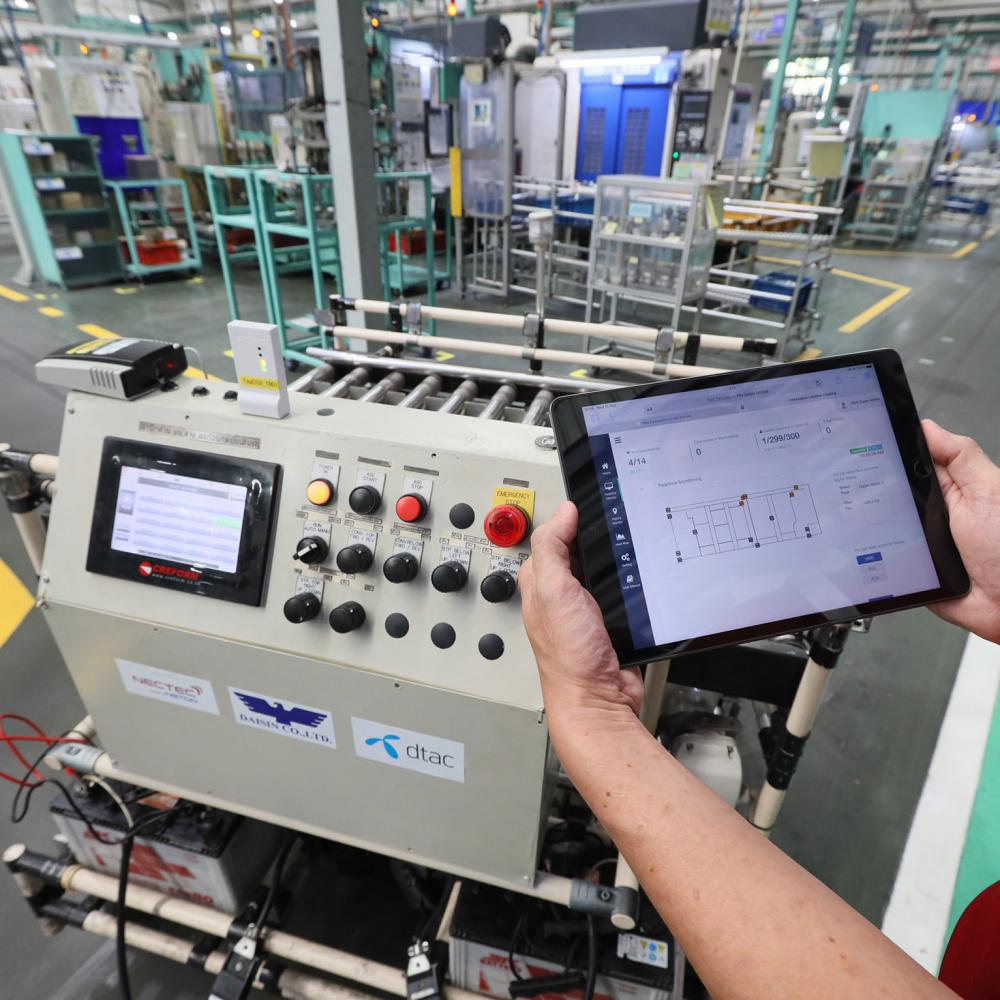Thailand is one of Southeast Asia's leading manufacturing hubs, especially for the production of automobiles. However, the challenges of the Covid-19 pandemic and the need to remain competitive mean that the nation must now focus on boosting sector productivity.

Daisin has adopted automated guided vehicles (AGVs) for parts delivery during the production process. Compared to AGVs, AMRs allow greater dynamism in helping personnel navigate through factories.
Automation has always been at the heart of boosting industrial productivity, but digital automation between manufacturers has been limited. Yet, as we enter Thailand 4.0, we are seeing the mainstreaming of applications that make use of more advanced technologies such as artificial intelligence (AI), machine learning, the internet of things (IoT), edge cloud computing and, most importantly, next-generation wireless connectivity provided by communications service providers and their technology partners.
Fixed cables or previous-generation wireless networks -- such as 3G and 4G -- are no longer practical for tomorrow's factories. In Thailand 4.0, the level of productivity, efficiency and operational agility enabled by more advanced digital applications require ultra-low network latency and reliability that legacy networks cannot provide.
New, industrial-grade private wireless solutions powered by 4.9G or 5G connectivity offer factory operators greater enterprise control and the capacity for long-term operability and efficiency. This is due to their more robust signals, lower latency and enhanced security -- factors contributing to unprecedented ability to sync with connected devices that can support human operations.
Another differentiator of these advanced systems is network slicing. This means that a dedicated "slice" of the network can be assigned to various specific operations. This can raise automation in factories to new levels as they adopt Industry 4.0 approaches such as digital twins, autonomous mobile robots (AMR), augmented and virtual reality as well as edge computing.
Digital twins refers to data-driven representations of physical systems using IoT sensors and analytics. The technology's transformational value has already been realised in Thailand -- most notably to create a 3D map of the Tham Luang cave to assist with the rescue of the young footballers trapped there in 2018.
For factories, digital twins allow operators to gain deeper insights via increased data collection to develop virtualised models of both machines and production lines. They can also help better understand how changes will affect equipment performance and reconfiguration to meet on-demand manufacturing.
Overall, digital twins enable the monitoring of every aspect of the factory environment to keep production quality high while also allowing for predictive maintenance to keep downtime low.
During the ongoing pandemic, digital twins were also used to improve vaccine production efficiency and safety, while doing the same for personal protective equipment manufacturing. In the automotive sector, vehicle manufacturers can use digital twins to simulate car models and assembly line processes for maximum efficiency.
SMARTER ROBOTS
Autonomous mobile robots (AMRs) can make large manufacturing environments more sophisticated, flexible and cost-effective. Compared to conventional automated guided vehicles (AGVs), AMRs allow greater dynamism in helping personnel navigate through factories.
AMRs can be enhanced further by a resilient, low-latency private wireless network to make them more intelligent and collaborative, as high-performance connectivity can empower smarter AMRs with context awareness and open-path navigation for obstacle and collision avoidance.
Such networks can also connect data and systems across the factory to keep AMRs updated on production line changes, in addition to using real-time data from onboard cameras and sensors to enable smarter collaboration between human and autonomous workforces.
In Thailand, the value of intelligent AMRs will be in the production of the robots themselves. This can then be adopted by other key manufacturing sectors such as electronics, a domestic sector that is already using AMRs in automation processes like precision assembly, as well as taking over duties in environments that are hazardous to human health. Not only do they reduce failure rates and material wastage, but also increase assembly efficiency, especially for complex products.
Edge computing, meanwhile, offers cloud capabilities and an IT service environment at the edge of the network. It is a powerful catalyst for innovation, as the edge environment is characterised by proximity, ultra-low latency and high bandwidth. Especially when enhanced with high-performance wireless connectivity, edge computing can also support computer-intensive IoT applications that use virtual and/or augmented reality.
Real-time data gathering allows for the direct feeding of information to workforces using connected devices (such as headsets and tablets) via VR or AR to quickly change setups and retool for new requirements.
DESIGN EDGE
For sectors such as automotive production, VR and AR can be applied to designing, prototyping and production. For example, in the production of electric vehicles, VR or AR can assist in creating virtual versions of specific batteries to determine the reliability and how it complements the vehicle. It also allows engineers to have more hands-on training to detect errors and further improve the vehicle.
Edge computing can also make production lines more productive and flexible, by enabling the combination of real-time data and historical profiles to automatically adjust systems for peak performance, while ensuring machines predict maintenance and prevent faults. This allows manual operations to be automated.
For example, using wireless robots and repurposing them as needed is useful in making production lines more flexible, which would then help to better facilitate operational continuity during disruptive crises such as the pandemic.
While the call for factories to digitise has been heard for years, there is heightened urgency to make operations more resilient during challenging economic periods. These applications can also create pathways of agility for improved future competitiveness.
Yet, to digitally transform the entire factory environment, all applications and processes must be underpinned by ubiquitous, highly reliable wireless connectivity. This means Thailand's government, businesses and communication service providers will have a catalysing, collaborative role in creating factories of the future.
Tanat Techatanabaht is the country director for Thailand and Cambodia of Nokia.